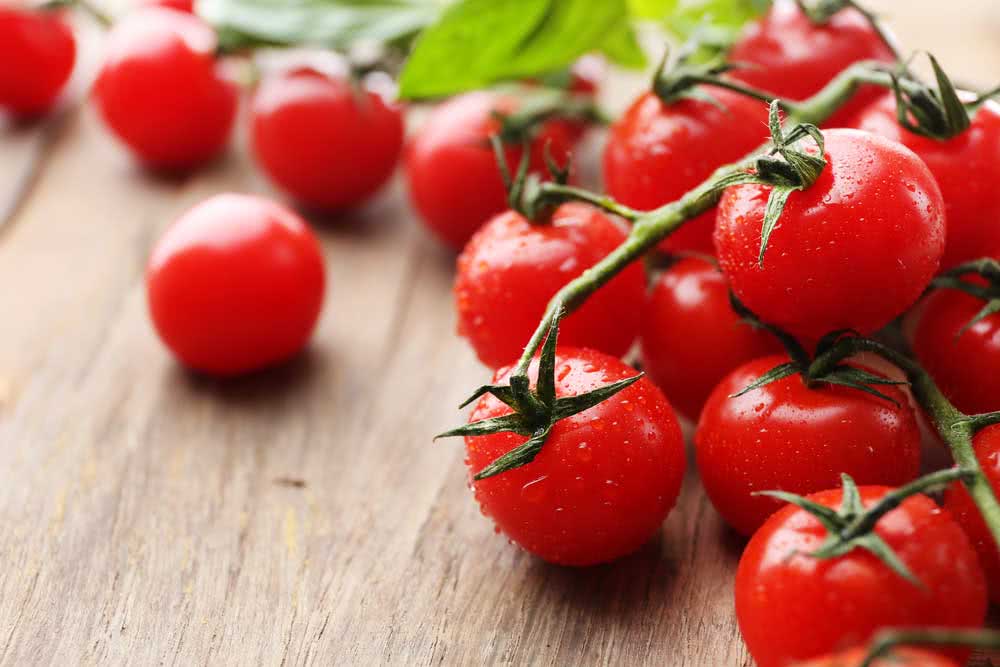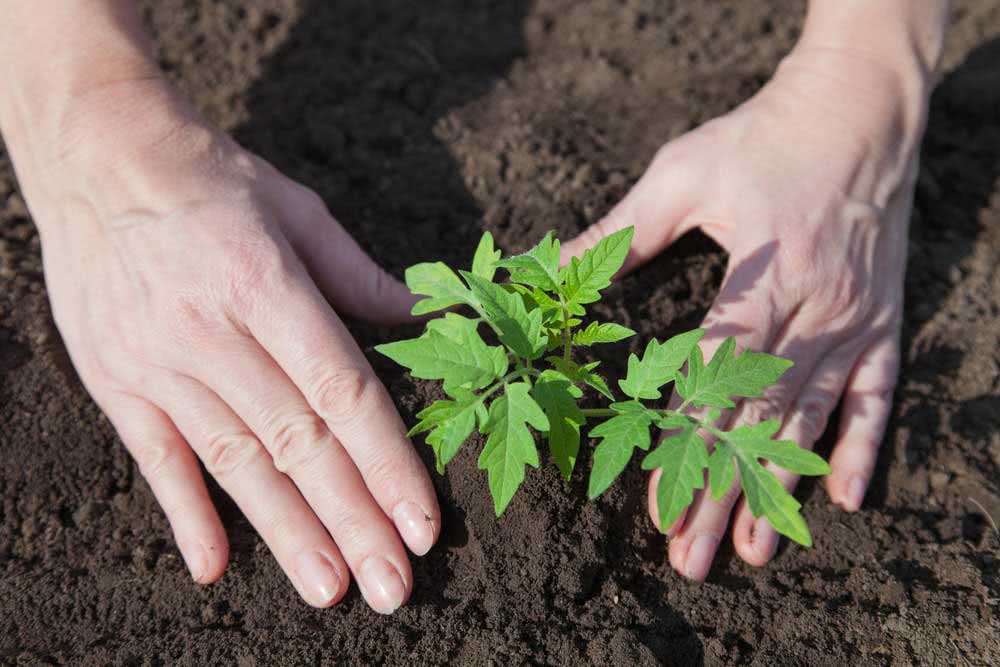Tomato is one of the main vegetables produced in Brazil and is also very popular on tables all over the country. Whether in salads, sandwiches or sauces, tomatoes are always present in our cuisine, even though they are one of the foods most affected by pesticides, according to ANVISA (National Health Surveillance Agency).
Now, imagine yourself picking your own tomatoes every day to make a delicious salad or Sunday special, without worrying about harmful chemicals. It would be a dream?
After reading our tomato planting tips, you’ll find that having your own tomato garden can be simpler than you might think. Follow up!
How to plant tomatoes: favorable conditions

Before starting your own tomato garden, it is important to acquire some basic knowledge about the cultivation of this vegetable, such as climate, soil conditions, watering etc. Come on?
1. What is the favorable climate for planting tomatoes?
The ideal temperature for growing tomatoes is between 20°C to 26°C. From 15°C it is already possible to cultivate tomato plants and obtain beautiful fruits. However, it is important that the maximum temperature does not exceed 35°C, as the tomato skin is very thin and can be “cooked” by the strong sun.
Want big, strong tomatoes? So give the seedlings plenty of light! Tomato seeds that germinate in the shade end up stretching and becoming weak. Seeds planted in a sunny place grow faster.
Regarding the incidence of light, the tomato plant must be exposed to high light directly for at least six hours every day.
2. When to plant tomatoes?
There is no way to plant tomatoes without considering the recommendations on the best planting time. According to Embrapa (Brazilian Agricultural Research Corporation), favorable planting is between the months of April and June.
Growing tomatoes from seeds takes about 6 to 8 weeks, from sowing to transplanting. This means that in a few months you will be able to taste the tomato you planted.
3. What should the soil conditions be?
Tomatoes are not very picky about the soil they are grown on. But it doesn’t hurt to help your tomatoes grow beautiful and healthy. Like most vegetables, tomatoes prefer fertile, well-draining soil with a pH of 5.8 to 7.0.
Tomatoes grow well in soil with lots of organic matter. You can incorporate organic compost when preparing the soil, but it’s even better if you have compost to add.
Another tip is to prepare a natural fertilizer rich in phosphorus and potassium. For tomato plants with lots of flowers and therefore lots of fruit, you can use dried pumpkin seeds crushed with banana skin.
4. How should tomato plants be watered?
As with other vegetables, you must be careful when watering. This information is very important for anyone who wants to learn how to plant tomatoes. Check if the soil is not moist enough and water the plant preferably always at the same time, in the early morning, while the sun is not yet strong, or at night.
Use a clear plastic or plastic film in the mouth of the container to keep moisture out. When the tomato plant starts to sprout, remove the plastic so that air can circulate. This effect works like a greenhouse and can be a great strategy for those who live in dry places.
5. What is the correct depth to plant the seed?
Seed depth should be a point of attention when planting tomatoes. Tomato seeds are very small, as you may have already noticed. If you plant them too deep in the ground, it will be very difficult for them to grow.
You can seed them by placing them about half an inch deep and lightly covering them with a moistened potting mix.
6. Now that I know how to plant tomatoes, when should I harvest tomatoes?
The harvest period varies according to the type of tomato planted and its form of development. Regularly growing tomatoes of the given type, which grow in bushes and bear fruit in less time, can be harvested between 7 and 8 weeks. This is the case with the Carmen or long life tomato.
Larger tomatoes can take between 10 and 16 weeks to ripen. This is the case with persimmon and gaucho tomatoes, for example.
The harvest must depend on the destination of the tomato. If it goes from your garden to your kitchen, the ideal is to let it ripen on the foot before harvesting it. Then, it’s from the garden for your pasta sauce, vinaigrette or your salad.
But, if the tomato needs to travel long distances, you can already harvest it right at the beginning of ripening so that it doesn’t spoil until it reaches the final consumer.
7. What type of tomato to plant?
Among the various types of tomato, we can highlight some for their resistance, flavor and production variety.
- Cherry tomatoes are small and sweet, excellent for salads and canapés.
- Italian tomatoes are ideal for dressing.
- Débora tomato is great for everyday use, as it goes well in both salad and sauce.
- The Carmem tomato is known as a long life, as it lasts a long time.
- Dutch tomatoes are excellent for salads, as they are not so acidic.
- Persimmon tomato is the best for making vinaigrette.
- The grape tomato is sweet and meaty, it looks like a miniature Italian tomato.
You can grow any of these types of tomatoes by following our tips. Think about the destination you want to give your tomatoes and choose your favorite.
8. Pests and diseases, how to solve the problem
Anyone who learns how to plant tomatoes needs to know that at some point they will possibly have to deal with some problems in their tomato plants. But here you will know what the main pests are and how to solve them without having to resort to pesticides.
- White fly: apply detergent, garlic and pepper syrup.
- Mites: apply onion syrup.
- Mining larva: apply a repellent made of alcohol and garlic.
- Aphids: apply garlic and onion extract.
How to plant tomatoes: step by step

Now that you know all the information you need to grow beautiful and healthy tomato plants, learn how to grow organic tomatoes by following our tutorial. Follow up!
Essential materials for anyone who wants to learn how to plant tomatoes
You will need:
- fair box
- 20 liter trash bag
- manual stapler
- expanded clay
- Bidim Geotextil blanket for garden or old piece of cloth (can be a floor cloth, old shirt, etc.)
- 5 kg of earth
- 3 kg of humus
- 1 kg sand
- tomato seeds
Step 1
Line the bottom of the fair box with the trash bag and staple along the edges and ends. If you don’t have a hand stapler at home, don’t worry as the weight of the earth can already support the garbage bag.
Step 2
Mix the indicated portions of earth, humus and sand and set aside, as you will use this mixture later.
Step 3
Cover the bottom of the box with a layer of expanded clay. It will serve to drain the irrigation water, preventing the soil from becoming soggy.
Step 4
Place the Bidim blanket or a piece of cloth over the expanded clay. The blanket’s function is to filter the water and separate the earth from the clay.
Step 5
Now, you must put the soil in the fair box until it covers the entire plastic bag.
Step 6
With your fingertip, drill holes no more than one centimeter deep in the earth, but be aware of the spacing between them. Consider that a market box holds up to six tomato plants, that is, six holes.
Step 7
To enhance germination, the ideal is that the seeds are removed from the tomato and dry for two to three days in the sun. However, the seeds freshly removed from the tomato can also germinate without having to go through this process.
Place 2-3 seeds in each hole, covering them carefully so as not to compact the soil.
Step 9
Always prefer to water the plant with a watering can or sprinkler, as this way the water will not fall so hard into the ground to the point of making a hole and hurting the seed, harming germination. Avoid strong hoses or squirts.
Remember that plants are very fragile in the early stages.
Step 10
Monitor the growth of your tomato plants, following guidelines on watering, soil quality, fertilization and keep an eye on possible pests. Also note, as they grow, if there is a need for supports made of stakes to make it easier for your tomatoes to receive the necessary lighting and fertilizer for their development.
Following these steps correctly, soon your tomatoes will be ready to be picked and enjoyed.
Did you like our tips on how to grow organic tomatoes?
Besides being very pleasant to be able to harvest your food from the foot, you consume a much healthier and nutritious plant, besides not harming the environment. We hope you enjoyed the tomato planting tips.
If you’ve grown organic food at home, share it with us in the comments!



